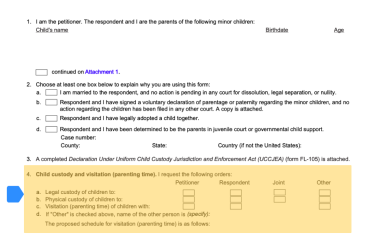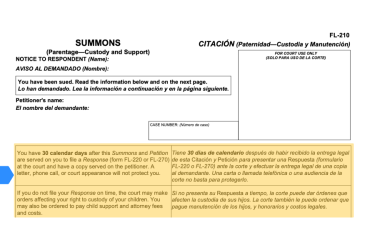What do these papers mean?
Petition and Summons (forms FL-260 and FL-210)
If you received these forms, your child's other parent is asking a judge to make orders about the care and support of your child.
This page will help you understand what the form means and your options for what to do next.

Who is asking
The person who filed the case is the Petitioner. This is typically the child's other parent. You will be listed as the Respondent.

What the other person wants the court to decide
On the Petition, the petitioner will have checked boxes to say what they want the court to decide.
-
Child custody and visitation (parenting time)
Item 4, and any attachments, state what custody and visitation (parenting time) orders they want the court to make
-
Child support
Item 6 explains that the court can make child support orders at any time.
The petitioner can also ask you to pay for the cost of their attorney. You can respond and say how you want the issues decided. If you don’t respond, they can ask the court to decide without your input.

How to respond and what happens if you don't
The Summons (FL-210) explains what you can do.
You can respond by filing a Response (form FL-270) in court.
If you don't file a Response within 30 days of getting these papers, the Petitioner can ask the court to decide the case without your input. This is called a default.
The court could make child custody, visitation (parenting time), and child support orders without your input.
If you agree with what the petitioner has asked for, you may choose not to respond and the case will continue the case without you.
In certain situations, instead of a response, you may want to file other papers telling the court that you don’t want to participate because the petitioner made a mistake in their case. Some examples include:
- There is already another case open
- The case was filed in the wrong place (e.g. the child doesn’t live in the county where the case is filed)
- You weren’t served properly
- The petitioner does not have the right (standing) to file
It is very important that you understand the consequences of responding or not responding to a case. Talk to your local Self-Help Center or an attorney for more information.
Things you cannot do now
Once you're served the Summons and Petition, there are things you can’t do without a written agreement from the Petitioner or a court order. They’re called Standard Family Law Restraining Orders.
For example, you can’t:
-
Take the child out of state
-
Get a new passport for the child
Read page 2 of the Summons for a complete list. These same rules apply to the Petitioner.
What to do next
Decide if you'll respond within 30 days
If you respond, this means you will participate in this court case and have input on any court decisions. You and the other person may still agree and not need to go to court. If you don’t agree, you can use a court process to have the court decide.
File your Response within 30 days of getting the Petition. After 30 days, the other person can ask for a default and the court can decide the case without you.
You can choose not to respond because you and the other person already have a written agreement. This is called a default with an agreement. The court will decide the case based on the information the other person provides.
Consider getting help
This website has information to walk you through the basic process. But, you may need more help or legal advice.
-
Get free help from the court. The court where the case is filed has a program where they offer free legal information about divorce. Learn more about the court’s Family Law Facilitator or Self-Help Center.
-
Hire a lawyer to help you with all or a part of your case. It’s possible to do this process without a lawyer. But, if you want, you can hire a lawyer.
What's next?
Explore your options
Select the options below to learn more about what happens next in each situation. You can also get step-by-step instructions and the forms you need for responding to the court case.
-
Respond to the petition and summons
Get step-by-step instructions for how to respond to a petition for child custody and support
-
Don’t respond, because you already have an agreement
Learn more about default with an agreement. The court will decide based on information from the other person, including your agreement.
-
Do nothing
Learn more about a default. This means the other person move the case forward without your input.

